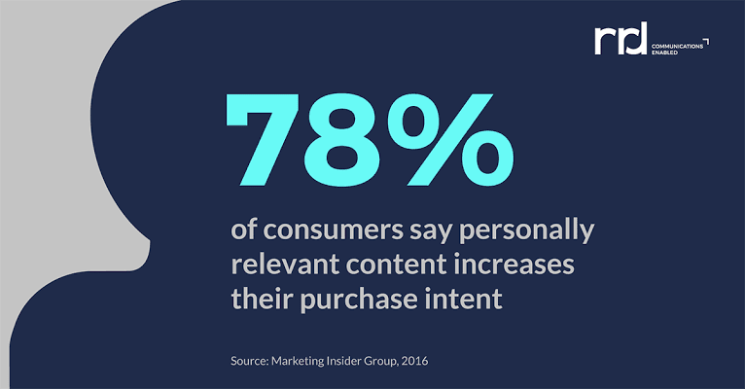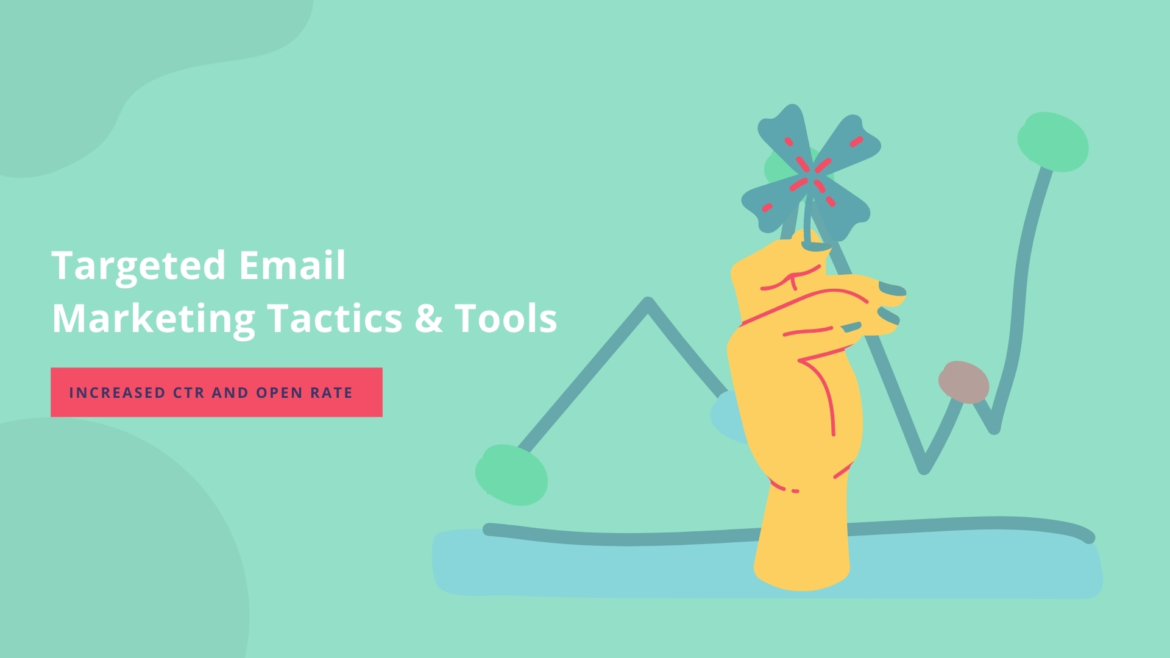In our previous articles, we have stressed the importance of making sure that your marketing includes elements of personalization. It is a staple in any marketing strategy, and it is one that customers have come to expect; if it is not there, it can significantly affect your relationships with some of them. Personalization is at the core of targeted email—and when billions of emails are sent each day (approximately 281.1 billion in 2018, with 347.3 billion expected in 2023), you want to make sure that the emails you are sending stand out and don’t get immediately moved to the virtual trash.

What is a Targeted Email?
A targeted email is one that is personalized, meaning you are targeting a specific type of customer based on a particular characteristic they have (such as their age or an interest in a particular product you offer). There are three qualifiers for an email to be considered a “targeted email”: It is pertinent, personal, and prompt.
- A targeted email is pertinent because it is relevant or applicable to the customer to whom you are sending the email. There is some element of personalization to make sure that the content is something that the customer is interested in; it is not just a generic message sent to an entire group without any consideration of who they are.
- Your email, if you can, should be personal. By this we mean that it doesn’t come from a company but a person. You’ll notice this tactic a lot when it comes to non-profits seeing donations: Someone in leadership—often the CEO or Executive Director—will send and sign the email at the end.
- You may have a limited window to send certain emails, which means you need to make sure that you are prompt in sending them. What they may need today, they may not need tomorrow: Either the need changed, or they found another company who could fill that need. If you notice they’re doing some “window shopping” on your website, identify what it is they are searching for—and then send an email crafted around that search.
Forbes recently compiled a list of statistics that prove just how powerful personalization is in marketing. You can read all 50 of the statistics in full, but these are the ones we found the most impressive (and convincing) in terms of targeted email marketing:
- Is your customer base mainly millennials? Make sure that you are sending them relevant emails, because 70% of them feel frustrated due to brands sending emails (which likely go right to the trash).
- Want to increase your click-through rate? Make sure your emails’ subject lines are personalized; you’ll increase chances of them being opened by 26%
- Money talks, and your increased revenue from a smart email campaign will speak volumes: Personalized and segmented email campaigns can see a 760% increase in revenue from email. Make sure to use those targeted email lists!

If increasing click-through rates, open rates, and revenue are goals of yours (and they should be!), then working to strategize and create effective targeted email marketing is a must. If you are already making efforts to create target email lists and send out targeted email advertising but aren’t seeing some results, there are several things you can try.
In this post, we’re going to:
- Assess your current efforts to get a sense of your strategies’ overall health
- Recommend some tactics to incorporate, all of which are statistically backed
- Provide some recommendations for types of tools that you can consider using
Once you have a better idea of how effective your strategy is and where its weak spots are, you can bolster it with new tactics and tools—and finally realize the click-through rate and open rates you’ve desired!
Analyze Your Current Efforts
Before we get into looking at targeted email tactics and types of tools, we need to start with the foundation, which is the targeted email marketing strategy that you already have in place. You should already be reviewing and analyzing your strategy periodically and making changes based on what your data tells you. But if you’re not, or if you’re not sure where to begin, we have outlined a few places below to give you some places to start.
Are Your Emails Actually Relevant?
Now is the time for you to be honest with yourself: Are you really sending out true targeted email? Your current click-through and open rates will provide an indication to that. If they’re a little lackluster and performing well below what you would like, then the emails that you are sending are likely not correctly targeting the right customers. For instance, maybe you didn’t segment your customers well initially. Another possibility is that the type of emails that you’re sending may not be appropriate for a specific demographic, meaning that even though you think your emails are personalized and relevant, they could be entirely missing the mark.
Customer Characteristics
Are you identifying all possible characteristics, appropriately segmenting your customers, and choosing what to target based on your goals? By segmenting, we mean grouping your total distribution list into smaller segments that are based on specific criteria. For example, you may have some customers who are parents and some that are not; if it is relevant to one of your goals, you may have a segment just for customers who are parents and a segment for those who are not parents. A beauty company may have segments based on age range, which would allow them to suggest products specific to needs those age groups tend to have. Standard customer characteristics that you’ll want to collect include gender, age, and interests. Depending on your company and what you provide to your customers, you may need to ask more specific demographic questions like ethnicity, religion, or income. But be warned: You can over inquire about your customers—even to the point of offending—and prevent them from signing up for your email list at all. You need to find a delicate balance.
There are also customer characteristics that you won’t have to ask for but will gather over time. These include previous purchases, product interests, purchase frequency, buying behavior, customers who abandon their carts (and at what rate), page views, call-to-action clicks, and more. You can use all of these to craft truly personalized emails.
Review Your Segments/Distribution Lists
Take a closer look at your segments or distribution lists. Is it specific enough, or is there still potential for opposing characteristics that can make your targeted emails ineffective for some? Are there some customers in segments that they should not be in? Do you need to start from scratch? Are your segments still supporting your business goals?
Remember that you will need to modify your strategies as you identify weak areas or means of improvement. You never want to keep using your strategies for months on end without taking time to evaluate their effectiveness. Ideally, you should conduct an evaluation of everything—from your strategy to your segments—on a quarterly basis. You could do it more frequently, but you need to allow for some time to pass to gather enough data to be able to analyze your strategy.
These are just three areas that you should evaluate in terms of your current efforts, but there are more, including listing out the tactics that you employ and any tools that you are using. How effective are these, and are they supporting you in meeting your goals? If not, what are the reasons? Are you doing it incorrectly? Are they just not working for your customer base? You may need to tweak your efforts a few times before you find something that works for you. And when you do, you’ll still need to regularly evaluate so you can maintain your results.
Finally, keep in mind that your lists should focus on quality over quantity. While you may have quite a few lists, they will be more specific to a segment of customers—meaning your emails are more likely to get the click-through and open rates you want.
Tactics to Start Using Now
The tactics that are listed here are backed by data: We are recommending using them because they are proven to work. And they all focus on some aspect of personalization for more effective targeted email marketing. According to The State of Digital Personalization in 2016, a joint study with Adestra and the Institute of Direct and Digital Marketing, 75% of email marketers believe that email personalization increases click-through rates while 82% saw higher open rates.
There are multiple tactics you can use to effectively personalize an email. Not all will be appropriate all the time, and while you can test out a few combinations, don’t think you need to use every possible tactic that’s out there. A little personalization can really go a long way.
Personalize Your Message
According to a June 2016 survey by the Statista Research Department, when an email had only a personalized message, the open rate was 18.8% and the click rate was 2.1%.

How you personalize your email message doesn’t need to be over the top. You can keep the subject line the same for all segments but modify the content based on characteristics like age, gender, and location. When you personalize the message, you are making it even more relevant to the customer—meaning they are more likely to be interested, especially if it addresses a specific need.
Make Your Messages Dynamic
According to a study by One Spot, a provider of personalization solutions, dynamic content is the most effective tactic according to 65% of email marketers.
There are multiple ways you can make the messages of your email dynamic—that is, changing based on user characteristics or other data like session behavior and previous purchases. Three ways to make your content dynamic are in the copy, in the images, and in the offers.
Dynamic Content
Your content should be dynamic, changing to best target customers based on characteristics or other data that you’ve collected, including purchase history, products viewed, and time spent on the website. One basic type of dynamic content is providing personalized recommendations.
The benefit of having personalized recommendations as a dynamic content option is that it’s never the same. Sure, the customer may receive different product recommendations each time, but what we’re talking about is the option to personalize recommendations based on various data.
- Base recommendations on highly-rated products by other customers in the same age group.
- Provide recommendations based on customer’s geo-location
- Use a combination of data gathered on a customer and data from similar customers to create recommendations
You may need to try a few types of personalized recommendations to see what kinds really resonate with your customers.
Dynamic Images
Personalizing the images that are in your targeted emails can make a big impact. If you are emailing a male customer that falls in the 35–44 age range, you’ll want to include photos of men that also fall in that age range. These photos will allow them to resonate more with the message that you are sending. Choose images that are going to appeal to your audience. If you’re a company that sells sports jerseys and you’re having a sale, you’ll want to promote teams specific to each region. A customer in Chicago won’t resonate with an image of jerseys from the Miami Dolphins or Colorado Avalanche.
Dynamic Offers
The third way to make your targeted emails dynamic is by offering dynamic offices. For example, if you have a customer that lives somewhere in the Midwest in the United States, but then their geo-location is tagged somewhere in California, you can send them offers specific to that location. These offers can also be based on other characteristics. How many emails do you get during your birthday month for free products or exclusive discounts? That’s just one instance of using a customer’s birthday to provide unique offers. Campaign Monitor highlights an email campaign by Adidas, in which they showed Rita Ora’s Originals line to their female subscribers and Pharrell’s Originals line to their male subscribers.

Make it Readable
This tactic has little to do with personalization but everything to do with readability. People decide within seconds whether they are going to read your email or delete it, so you need to make every second—all three of them—count. That’s why you need to make your email easy to read, and the best way to do that is to make it scannable so they can absorb most of the information quickly. Ways to achieve this include:
- Putting the most important information at the beginning of the email
- Making call-to-actions easy to find
- Group content under headers; this visually breaks it up as well, making it easier to read
- Use bullets where you can
- Include images that are eye catching and serve a purpose (don’t just include an image for the sake of including one)

Types of Tools to Consider
Artificial Intelligence (AI) / Machine Learning
Artificial intelligence and machine learning can help us by sifting through data and identifying trends or opportunities at incredible speeds; for a human to do the same analysis is impossible. Having some type of artificial intelligence assist you in your targeted email marketing can impact your click-through and open rates in a big way.
For example, artificial intelligence can learn the habits of your customers. If a customer is more active in the afternoon, then it will send the email during that time—and not in the morning or evening when it may be ignored. And while artificial intelligence learns over time, you can send a questionnaire to your targeted email lists to learn more about their preferences right away; it will then take these preferences into account.
Automated Emails
One consideration is finding a tool that will automatically send emails based on certain customer actions. You’re probably familiar with this: Have you ever been online shopping, added something to your cart, and left the webpage without checking out? In a day or two, you’re likely to find an email with a subject line similar to: “Did you forget something?” This email is a follow up that is encouraging you to complete your purchase; sometimes, it even comes with an offer for a discount.
By sending automated emails, you are taking out the brunt work of doing it on your own. An email will be generated and sent based on user action and, since it is automated, it will always be sent in the proper amount of time. Use a simple follow-up tool for automated emails to send out birthday messages, coupon codes, reminders, and more.
Email Distribution Tool
There are many services out there that provide an all-in-one tool when it comes to creating and sending emails to your targeted email lists. These types of tools make it easier for you to send out emails and can reduce the time that you’re spending on them. Look into tools that have an email builder that you can use to drag-and-drop headers, content, and images with ease. Another good feature to have is some type of insight or analysis tool, so you can see what is working and what isn’t. Finally, having the capability to easily segment all of your contacts into various groups is a must.


